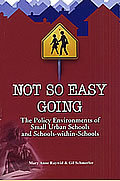 By Mary Anne Raywid and Gil Schmerler
By Mary Anne Raywid and Gil Schmerler
(ERIC Clearinghouse on Rural Education and Small Schools, 108 pages, $13.00)
reviewed by Jill Davidson
In Not So Easy Going, co-authors Mary Anne Raywid and Gil Schmerler look at crises and successes in a variety of small schools to analyze the effects of policy environments. Their findings validate the experience of many CES educators: states and districts seek high achievement from students. But by adhering to outdated systems and assumptions, individual schools encounter seemingly endless barriers to autonomy, frustrating their efforts to downsize and thereby thwarting their best chances to create conditions for student success.
Raywid and Schmerler analyze this maddening phenomenon through stories from New York, Boston, Chicago, Philadelphia, and Portland (and, incongruously, rural Hawaii). The second chapter discusses New York City’s small schools phenomenon as it unfolded in the 1970s and 1980s. Among other subjects, this chapter looks at the under-reported story of Deborah Meier’s Learning Zones initiative, which would have grouped schools by orientation and focus rather than geography and would have swapped out “bureaucratic school control” for “interactive professional monitoring.” Stephen E. Phillips, the first New York City superintendent of alternative schools, contributed the third chapter, an instructive history of small schools’ growth in New York from the policy-maker perspective.
The next three chapters discuss the fate of small schools in Chicago, Philadelphia, and Boston, finding weaknesses due to lack of district commitment, state financial restrictions that caused priority shifts, and, in the case of Boston, the persistence of the Boston pilot schools as a “fringe” movement, a condition that preserved autonomy but limited their influence on the overall system. Analyses of individual schools follow, drawing lessons from Queens, New York’s International High School, Portland, Oregon’s Environmental Middle School, and New York City’s Julia Richman Educational complex.
Not So Easy Going concludes with an summary of the system change that needs to happen, positing ten factors that will influence the creation of “safer, more humane, and more effective” small schools. This list doesn’t solve problems: Raywid and Schmerler aren’t out to suggest easy fixes. But their observations realistically describe the complexity of creating better schools.
